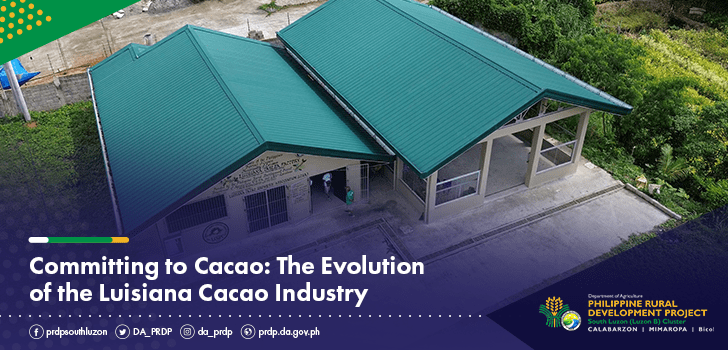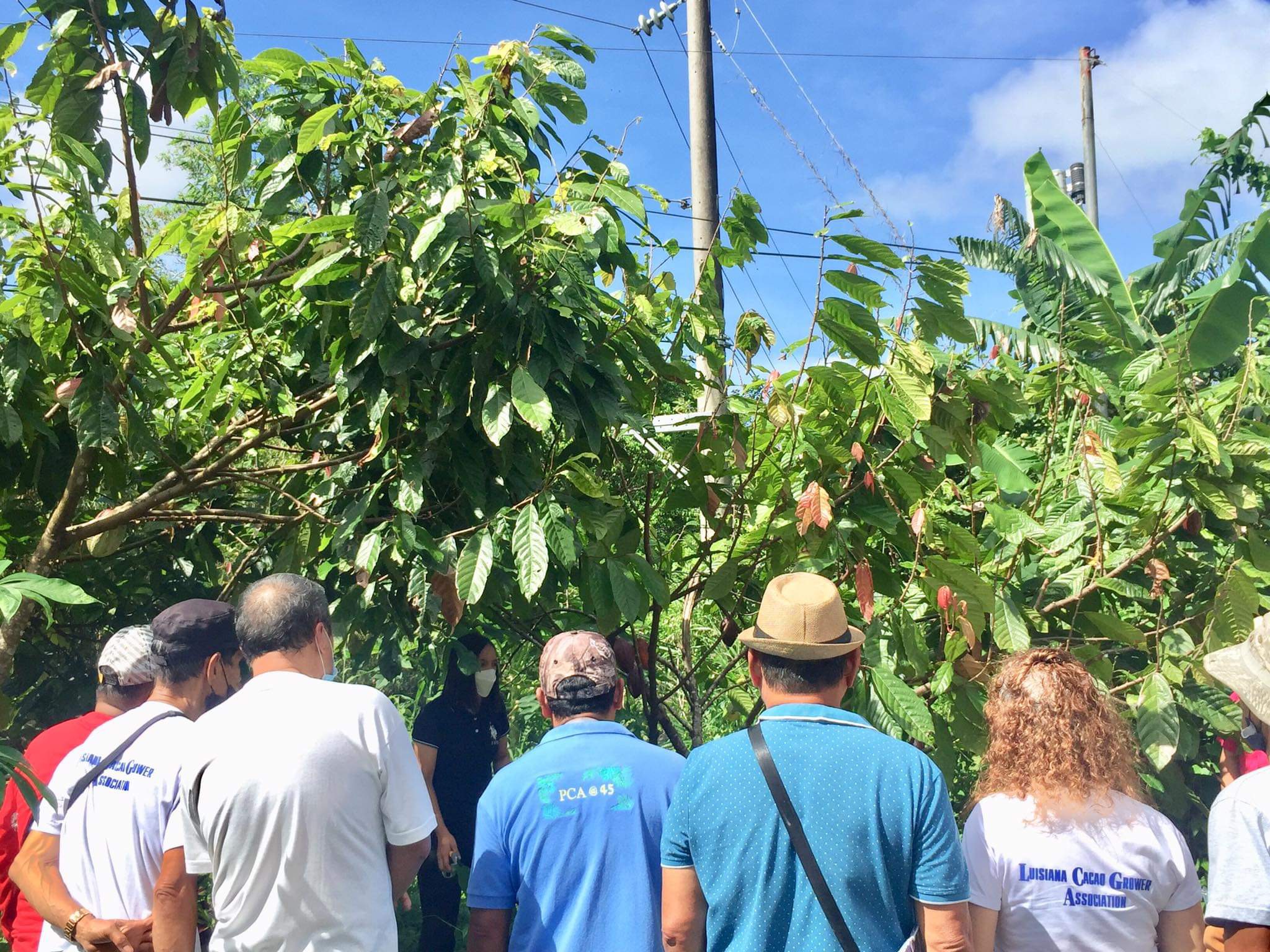
Committing to Cacao: The Evolution of the Luisiana Cacao Industry
In Luisiana, Laguna, cacao is considered a mainstay in family dining tables, especially during special occasions like Christmas and fiestas. The core ingredient of warming and filling classic delicacies like hot chocolate or champorado, cacao was indeed a much-awaited and deserved treat for the locals, nourishing them with joy from its taste, and renewal from its natural health benefits.
Cacao trees naturally grow in Luisiana with its long wet seasons, but in the past, farmers were paying more attention to more profitable crops such as coconut. However, when Cocolisap struck Luisiana in 2015, local coconut production hit a low. Pushed to a corner, farmers had to find alternative sources of income for their families. And in the very site of their damaged coconut trees, farmers found hope in their intercropped cacao trees.
Despite cacao having a relatively lower profitability than coconut, some farmers braved to believe in its potential. With the support of the Department of Agriculture, through the High Value Crops Development Program and the municipal agriculture office, farmers were given resources and knowledge to expand cacao production in their municipality. With its success, a group of farmers decided to fully commit themselves to developing the local cacao industry, hence the birth of the Luisiana Cacao Growers’ Association (LCGA).
The LCGA, now known as the Luisiana Cacao Grower Producers Cooperative (LCGPC), dreams big for the Luisiana cacao industry and their fellow farmers. They aimed to go beyond producing cacao and process it into tablea and elevate its value in the market. Hence, with the help of the DA-HVCDP and the municipal agriculture office, they started a small cacao processing enterprise. In just a few years, the enterprise has shown great potential to fulfill a bigger dream: to make Luisiana the cacao capital of the Philippines.
In 2017, the cooperative and the Luisiana municipal government partnered with the Department of Agriculture – Philippine Rural Development Project (DA-PRDP) to upgrade their cacao processing enterprise. The cooperative received two processing facilities and processing equipment worth PhP 8,522,462.14.
“Gusto naming magtuloy-tuloy itong processing para mas ma-encourage pang magtanim ang mga magsasaka. Kung may maayos at malakihan kaming processing, ang magsasaka ay gaganahang magtanim dahil may sure buyer ang kanilang harvest,” shared Pedrito Mergilla, chairman of the LCGPC.
From manually roasting two to three kilograms of cacao at a time in a wok and a stove, the LCGPC can now process 10 kilos in one batch using a roasting machine in a matter of minutes. They also now have their grinder; hence they do not have to avail grinding services elsewhere which may also contaminate their roasted beans. Molding the tablea has also been made easier as the ground cacao gets a finer texture through the colloid machine and molding materials granted by the DA-PRDP. From producing 50 boxes for days, the LCGPC can now produce 550-600 boxes in a month.
With more efficient processing operations and improved product quality, the LCGPC was able to raise the price of their product from PhP 100 to PhP 120. Their products have caught the interest of customers both inside and outside Luisiana. Through their earnings, the cooperative established a chocolate shop located at the center of Luisiana in partnership with the Luisiana municipal government.
The LCGPC also created jobs for their members, helping them maintain a stable income especially when cacao is not in season. The cooperative has hired salespeople, processors, and administrative staff for the chocolate shop, and pays them PhP 380.00 daily.
“Nakakatulong ang sinesweldo namin sa kooperatiba dahil naiibayad namin ito sa mga bills at pandagdag baon na rin sa aming mga estudyante,” shared Rina Tatad, one of the employees.
As their enterprise reaches new heights, the LCGPC remains grounded to their purpose of helping their fellow farmers improve their lives. Whether farmers are members or not, the LCGPC buys raw materials from anyone who offers their harvests. Currently, the LCGPC is also exploring the production and marketing of other cacao products like briquettes, candy, and wine to fully utilize their raw materials.
“During peak season wala kaming pinapalampas na cacao. Kahit po hindi members, binibili na rin namin ang cacao nila. Tulong na rin sa aming mga magsasaka para sila ay maenganyong magtanim at magparami pa uli ng cacao. Binibigyan namin sila ng lakas ng loob,” shared Mergilla.
“Ako po’y nakaranas ng mga pagsubok tungkol po sa aking mga tanim na cacao. Ang iba po ay mga nangamatay. Pero ako po ay nagpapatuloy dahil alam ko pong darating at darating ang panahon na ito ay magu-grow at magkakaroon po ng magandang pagkakakitaan dahil meron po tayong pabrika, meron rin po tayong mamimili,” shared Marianito Arancel, a farmer-member.
The cooperative also continues its strong partnership with the local agriculture office and the Department of Agriculture toward the sustainability of the enterprise subproject and the production of cacao in the locality. Recently, the local agriculture office provided local cacao farmers with 5,000 cacao seedlings to increase production. Meanwhile, the cooperative also received training on food processing and safety from the DA-PRDP Regional Project Coordination Office Calabarzon and Department of Science and Technology Calabarzon.
“Sinisikap po namin na ang aming tablea ay magka-FDA at LTO para madala namin sa department store. Ngayon ay tinuturuan kami ng DOST at PRDP sa paggawa ng GMP Manual para makapasa sa requirement ng FDA para maiparehistro ang aming product,” shared Mergilla.
From being a commodity processed only for personal consumption and special occasions, cacao is now a thriving commodity in Luisiana that is seen to bring forth further economic development in the locality and the Calabarzon region. Through the commitment, dedication, and collaboration of the LCGPC, the local government, the DA-4A, and the DA-PRDP, cacao production in Luisiana has evolved into a profitable venture that can sustain several families and communities for more years to come.
“Ikinagagalak ko pong sabihin na sa pamamagitan ng PRDP talagang nakita ng samahan na ito ay napakalaking bagay dahil ang aming mga growers ay nabigyan ng lakas ng loob na pagandahin at palawakin dahil nga nakita nila na nandito na ang merkado. Sa pamamagitan ng mga magtatanim namin, ang Luisiana ay unti-unti nang nakikilala ang produktong tablea.“ Mergilla said. #

The Luisiana Cacao Grower Producers Cooperative determination to process cacao as a new source of income, complemented by the intervention and support of the DA-4A HVCDP and the LGU, created a new hope for several farmers to continue with their livelihood after being struck by cocolisap in 2015. (Screencap from DA-4A RAFIS)

LCGPC members also spend more time and attention in roasting their cacao beans back then. Using a wok and stove then, they can only roast around 2 kg of cacao beans at a time. They must also pay attention to the beans and mix them constantly to ensure that they will be evenly roasted. (Screencap from DA-4A RAFIS)

Before the interventions, most of the time and energy of LCGPC members are spent on deshelling cacao beans for roasting. Aside from being time-consuming, the work also poses hazards on the members as they are more prone to injuries. (Screencap from DA-4A RAFIS)

For the LCGPC, the colloid machine they received from the DA-PRDP subproject has substantially elevated the quality of their tablea product now that their cacao has a finer texture. They are now assured that consumers will no longer find cacao shells/bits in their tablea. (Photo by Myrelle Joy Bejasa)

Now that cacao is more widely produced and processed in Luisiana, hot chocolate has become a staple snack in the municipality, best paired with local rice cake/suman. (Photo by DA-4A RAFIS)

Because of the improved texture of the LCGPC’s cacao, it is also now easier to mold. Molding has also been made faster as the LCGPC were also provided molding tools and a refrigerator by the DA-PRDP subproject. (Photo by DA-4A RAFIS)

Ireneo Veluz, one of the LCGPC’s processors and member of board of directors said that the interventions and support they received made them more inspired to continue and expand their enterprise as their success enabled them to help more fellow cacao farmers and made cacao a top product in their municipality. (Photo by Myrelle Joy Bejasa)

The LCGPC’s tablea is made from 100% cacao. Consumers can be assured that with every sip, they’ll get to taste pure cacao and enjoy its multiple health benefits. It is also affordable for many with a price of PhP 120. (Photo by Myrelle Joy Bejasa)

Now that the LCGPC has a grinding machine from the DA-PRDP subproject, they can now avoid product contamination and paying extra money since they do not have to bring their cacao outside and avail grinding services elsewhere. (Photo by Myrelle Joy Bejasa)

With the assistance and support of the DA-4A and the LGU, farmers in Luisiana are determined to make cacao a mainstay and leading product of their municipality which will sustain their families and everyday life for a long time. (Photo from Rina Tatad)

Aside from cacao production, the LCGPC also wanted to expand cacao marketing in their municipality. Hence, using their earnings in the previous years, they established a chocolate shop in the town proper with the assistance and support of the LGU. Conveniently located near the municipal hall, church, and the park, the LCGPC chocolate shop rarely have dull days. (Photo by Myrelle Joy Bejasa)

